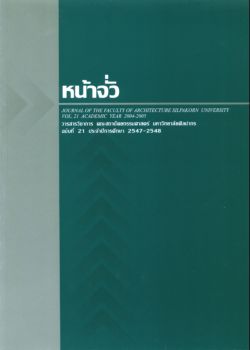การก่อสร้างโดยใช้แบบหล่อคอนกรีตเสริมเหล็กพร้อมเหล็กเสริม
Keywords:
ไม้เนื้ออ่อน, ไม้แบบ, แบบหล่อคอนกรีตเสริมเหล็ก, Softwoods, Formworks, Reinforced concrete with partial steel reinforcing membersAbstract
ในการก่อสร้างอาคารคอนกรีตเสริมเหล็กโดยวิธีการใช้ไม้แบบ ซึ่งเป็นวิธีการก่อสร้างทั่วไป จะต้องมีการเตรียมการทําแบบหล่อ ซึ่งต้องมีโครงไมัรัดแบบและค่ํายัน ซึ่งส่วนมากจะทําด้วยไม้และตามด้วยการผูกเหล็กเสริม ซึ่งงานทั้งสองประเภทนี้จะแยกกันทํา จากการที่ต้องลําเลียงวัสดุต่างๆ การจัดหาที่จัดเก็บและการจัดหาแรงงานที่ชํานาญงาน ทั้งงานไม้และงานเหล็ก ประกอบกับคณภาพของไม้แบบในปัจจุบันเป็นไม้เนื้ออ่อนจึงทําให้มีการบิดตัวหลังจากการใช้เพียงครั้งเดียว ทําให้โอกาสที่จะนําไปใช้ซ้ำได้น้อย จึงมีความสินเปลืองวัสดุ แรงงาน และสถานที่ในการจัดเก็บหรือกําจัดออกจากสถานทีก่อสร้าง อีกทั้งขนาดการใช้กับขนาดของวัสดุที่ผลิตไม่ลงตัว ทําให้มีเศษวัสดุมาก การตัดไม้เนื้ออ่อนเพื่อนํามาใช้เป็นไม้แบบจึงต้องตัดไม้มากขึ้น ซึ่งไม่เป็นผลดีต่อการฟื้นคืนสภาพป่าสีเขียว เนื่องจากไม้เนื้ออ่อนเป็นไม้ให้ร่มเงาเป็นความหวังในการฟื้นคืนสภาพของป่าหลังการทําป่าไมัเนื้อแข็งในเชิงพาณิชย์ไปแล้ว ดังนั้น ในฐานะสถาปนิกการก่อสร้าง โดยการใช้แบบหล่อคอนกรีตเสริมเหล็กพร้อมเหล็กเสริมนํามาผลิตรวมกันล่วงหน้าที่นําเสนอถึงแม้ไม่สามารถหยุดการใช้ไม้แบบ แต่ก็เป็นแนวทางหนึ่งที่จะช่วยลดการใช้ไม้แบบซึ่งจะช่วยส่งเสริมให้ป่าไม้ฟื้นตัวเป็นสีเขียวเร็วยิ่งขึ้น อีกทั้งยังช่วยประหยัดเวลา และค่าก่อสร้างโดยรวมได้มากกว่าวิธีการก่อสร้างโดยปกติ เช่นเดียวกับการใช้พื้นสําเร็จรูปเมื่อหลายปีก่อนที่ช่วยให้การก่อสร้างพื้น คสล. สะดวกรวดเร็วและประหยัดเวลา
The Use of Reinforced Concrete With Partial Steel Reinforcing Members in Construction
Using softwoods as formwork for reinforced concrete construction is generally accepted in Thailand. Only a few years ago, even medium - soft woods that can be used and reused several times was a subject of endless complaints by most builders. Now, even though known for being frequently deformed after only one use, softwoods are still the only available choice for formworks. The problem is that more and more trees have to be felled. Our rain—forests therefore, are depleting as the pace of construction grows at a rapid rate. As canopy trees, they are our only hope for reforestation since hardwood forests have been widely exploited commercially. Despite the fact that their use as formwork involves complexities such as requiring various sizes of wood, the need for other materials in the process which have to be transported from various locations, and the necessary skill-labours just to cast a single reinforced concrete beam, this method has been in practice for centuries. The introduction of reinforced concrete with partial steel reinforcing members is therefore intended to be a substitute. It will change our reinforced concrete construction work in the same manner, or even greater, as the pre-cast concrete flooring system did some years ago when we witnessed a faster, simpler and more economical way to cast floor slabs. However, successful or not, it remains to be in our judgement as architects who are concerned with resources and who are in a position to demand a faster, simpler, and cheaper means of construction. “If we cannot stop using wood totally, at least we can stop using them wastefully”





